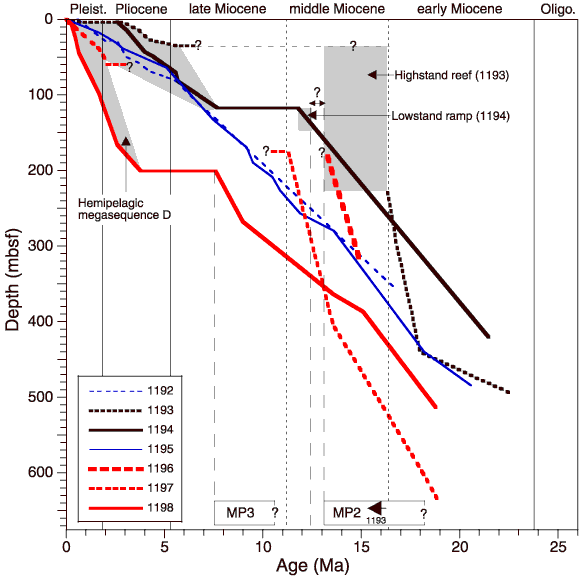Figure F11. Sedimentation rates at Leg 194 sites. Sites 1195 and 1192 trends are very similar and represent distal, drift-dominated deposition at rates of ~30 m/m.y. during the Miocene and 15 m/m.y. during the Pliocene-Pleistocene. The decrease in depositional rates at ~5 Ma probably reflects the decrease in nearby carbonate shedding. Carbonate platform Site 1193 shows a dramatic increase in depositional rates from 15 m/m.y. to 150 m/m.y. in the late early Miocene, probably heralding the approaching carbonate platform. Sedimentation rates in the overlying platform, which started to accumulate at Site 1193 at the beginning of the middle Miocene (~16 Ma) are nor directly defined. However, neritic upper-slope deposition (>100 m paleowater depth) at the adjacent slope Site 1194 evolved into a neritic ramp (>60 m paleowater depth) at ~12.8 Ma, suggesting a major sea level fall that would have exposed Site 1193 and ended MP2 phase carbonate buildup there. The presumed lowstand ramp deposition at Site 1194 ended at 11.5-12 Ma (hiatus at 117 mbsf). The time involved in the sea level fall is not constrained, the uncorrected magnitude relative to the present strata was ~115 m. At Site 1196 (and Site 1199, not shown), platform growth rates of at least 80 m/m.y. are documented for an ~ 140 m thick middle Miocene interval, but subsequent growth could not be constrained in time. Adjacent slope Site 1197 shows increased depositional rates in the late middle Miocene, which is interrupted near the middle late Miocene boundary (11.1-? Ma; hiatus at 175 mbsf), a time of inferred sea level rise at Site 1194. Subsequent late Miocene (and early Pliocene?) platform shedding is only roughly constrained in time at Site 1197 (5-11 Ma). However, the other slope site adjacent to the platform Site 1196, Site 1198, documents increased platform shedding (~50 m/m.y.) during the middle late Miocene, a time of apparent nondeposition at Sites 1193 and 1194. Deposition at Site 1198 ended at ~7.8 Ma (hiatus at 200 mbsf), which probably marks the end of the MP# phase of carbonate buildup at Site 1196. This starvation, lasting several million years, probably also occurred at Site 1197 (hiatus at 59 mbsf). The shaded area in the top left corner of the diagram highlights the records of the hemipelagic seismic Megasequence D, which fills in the topography created by the Miocene carbonate buildup. The oldest Megasequence D records (7.2-7.8 Ma) were recovered at Sites 1192, 1194, and 1195. This time coincides with the starvation of periplatform deposition at Site 1198 and could mark the onset of widespread drowning of the carbonate factory. The thickest record of Megasequence D (200 m), accumulated since ~3.6 Ma, was recovered at the drift focus Site 1198.MP = Marion Plateau.
